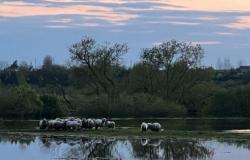According to the new amendments, in order to preserve biological diversity in the forests of forest groups II-IVA, it is mandatory to leave all oak trees with a diameter of at least 150 cm in the exchanges (if there are none, leave at least one oak tree with a diameter of at least 50 cm per hectare), 130 cm – aspens, 95 cm – larch, ash, 85 cm – pine, beech, maple, hemlock, elm, linden, 75 cm – hemlock, hornbeam (if any). Trees at risk cannot be selected as important for biodiversity.
Several provisions on sanitary logging have also changed. From now on, it is permitted (but not mandatory) to clear sanitary felling of stands damaged by abiotic factors, diseases or forest pests, where it is not possible to improve the sanitary condition of the stand by other means of forest sanitary protection and where, assessed according to the requirements of the Forest Sanitary Protection Rules, it is found to be severely damaged trees and shrubs make up at least 10 percent, and if they are cut down, the following would remain:
- In forest group II forests – 0.2 and lower stand density;
- In the forests of forest groups III and IV, 0.4 and lower stand density (this provision was also valid before);
- In fir trees of the IV forest group, which are not included in the protected territories, which are registered in the State Cadastre of Protected Territories, the density of the stand is 0.5 and less.”
From the point of view of carrying out sanitary fellings, it has been established that when cutting forests of the IIA forest group or the protected areas of the III forest group with clear sanitary fellings, all healthy and little damaged trees, resistant to abiotic factors, must be left (with the exception of firs of the I ard, when the felling is carried out due to dangerous spread of tree trunk pests, and dangerous trees).
The following new points have also been added to the rules:
- When felling a forest of forest group IIB, all trees must be left intact, trees resistant to abiotic factors (with the exception of firs of the I ard, when felling is carried out due to the spread of dangerous pests of tree trunks, and trees that pose a risk).
- When, after sanitary felling, a stand of 0.3 or less is left and there are conditions for the forest to recover or to apply a mixed method of forest restoration (slicing and greening), forest restoration measures must be applied (encouraging self-sprouting of the forest, preserving self-stems of promising target tree species, undergrowth, performing their maintenance and protection) in accordance with the provisions of forest restoration and planting.
The full text of the document can be found here.






